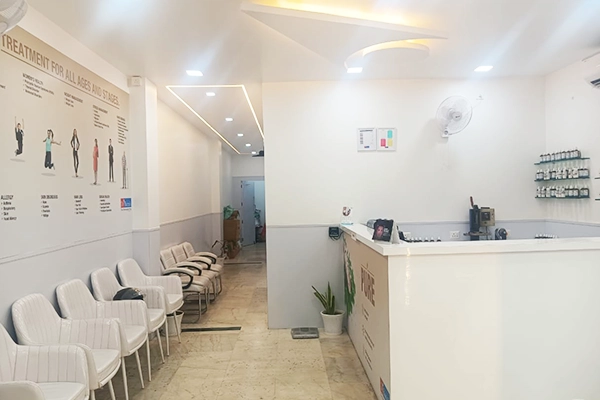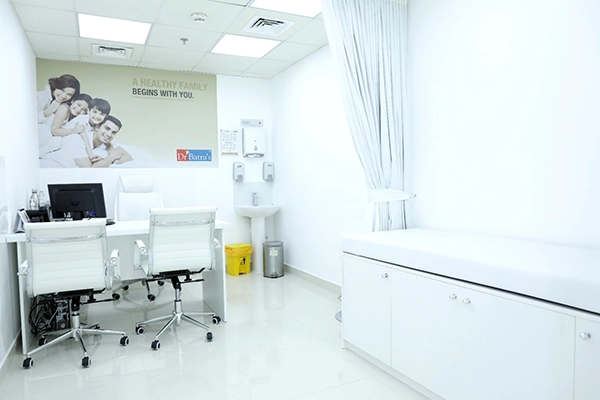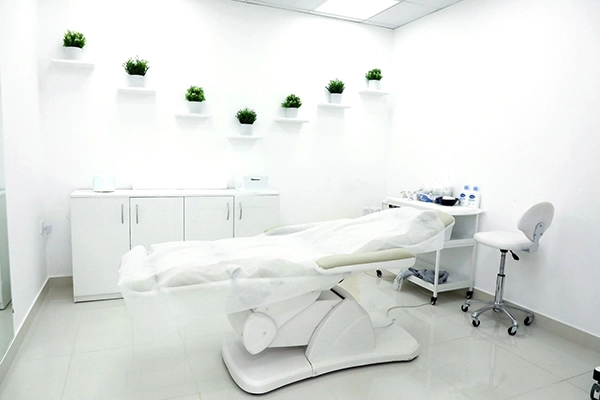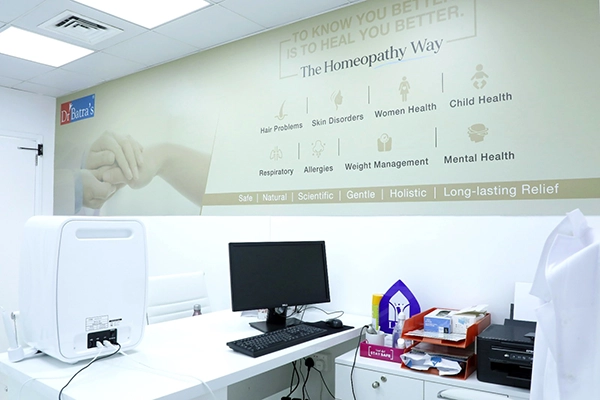Alopecia Treatment in Dubai & Abu Dhabi UAE
Get Alopecia Treatment in Dubai & Abu Dhabi at Dr Batra’s®, UAE’s leading homeopathic experts in hair treatments.
With over 4 decades of experience and more than 1.5 million cases of hair loss treated globally, you can rest assured that you’re in safe hands.
Our homeopathic treatment for alopecia aims to address the root causes, such as stress, hormonal imbalances, and genetic factors, by stimulating the body's innate healing mechanisms. We combine holistic homeopathy with our advanced technologies to treat the root cause of your Alopecia, not merely the symptoms of it.
Our treatment plan is customized to suit your unique needs and situation, so you’ll be getting a comprehensive strategy that includes lifestyle modifications like stress management and dietary adjustments to support hair regrowth and prevent further hair loss.
Alopecia, a condition that leads to hair loss, is a common concern among residents in the UAE, with a Gulf News article revealing that 67% of surveyed individuals experience this issue. Both men and women are affected by alopecia, with the early stages often going unnoticed.
Why Choose Dr Batra's® for Alopecia Treatment in Dubai & Abu Dhabi?
At Dr. Batra’s Homeopathic Clinics UAE clinics, we provide natural, painless solutions customised to each patient, combining homeopathy with advanced treatments. Our clinics in Dubai use advanced diagnostic tools like video-microscopy and Hair AI Pro for accurate assessment.
The holistic approach integrates homeopathy with aesthetic treatments, supported by experienced specialists who prioritize individualized care. Choosing Dr Batra's® means opting for a reliable, long-term solution for hair loss.
Get Alopecia Treatment at Conveniently Located Clinics in Dubai & Abu Dhabi
Advanced Hair Growth Treatment provided by Dr Batra
Artificial intelligence-led hair analysis
Dr Batra’s® employs Artificial intelligence-led diagnosis developed by South Korean scientists, certified under ISO 9001 and ISO 13485, holding six patents for advanced medical devices. The AI-driven system enhances diagnosis, treatment customization, and progress tracking:
- Accurate Diagnosis: Latest scientific tools provide precise hair and scalp analysis.
- Prognosis and Customization: AI predicts treatment progression and suggests personalized regimens based on a database of 1.5 million patient records.
- Measurable Outcomes: Progress reports and charts scientifically document patient improvements.
Dr Batra's® Exosome Based Hair Treatment - XOGEN
- Promoting Hair Growth: Exosomes contain growth factors that encourage the development of new hair follicles, resulting in fuller and thicker hair.
- Improving Hair Follicle Health: Exosomes help prevent further hair loss, stimulate denser hair growth, and enhance the health of existing hair follicles.
- Non-Invasive Treatment: Exosome therapy is a non-invasive alternative to risky procedures like surgery, making it suitable for many individuals.
- Minimal Downtime: Patients undergoing exosome therapy for hair loss experience short recovery times, allowing them to resume daily activities quickly.
- Safe and Effective: Exosome therapy is safe, minimally invasive, and offers long-lasting results without requiring downtime or recovery periods
- Customizable Treatment: Exosome therapy can be tailored to individual needs, with the concentration of exosomes adjusted for optimal results and combined with other treatments for enhanced effectiveness
- Regeneration and Tissue Repair: Exosomes stimulate the growth of new tissues, regenerate damaged hair follicles, and promote the growth of new, healthy hair, leading to improved hair growth and thickness.
Hair Growth Treatment
Dr Batra’s® Treatment incorporates state-of-the-art French technology and Korean serums with plant cells and multivitamins. Designed to enhance hair thickness and follicle renewal, the treatment includes:
- Cleaning the dandruff.
- HVT for improving blood circulation.
- Heating to open scalp pores.
- Derma Roller and Serum infusion for deeper penetration.
- Electroporation to facilitate serum absorption and pore closure.
Visible results are typically observed in 10 sessions, with optimal outcomes after 20 sessions, achieving an 88% success rate. This treatment excludes patients with active hair fall, low ferritin, TSH imbalance, PCOD, and uncontrolled diabetes.
groHair Treatment
Dr Batra’s® groHair Treatment involves non-needle therapy to stimulate hair growth, strength, and quality:
- Cleaning the dandruff.
- HVT for enhanced blood circulation.
- Heating to open pores.
- Electroporation for serum infusion.
- Cooling to close pores.
Visible results can be seen in 10 sessions, with the best results after 20 sessions, and a 77% success rate. Similar exclusion criteria apply as with the Hair Growth treatment.
Hair Vitalizing Treatment
This treatment uses hair therapy to boost cellular activity and promote thick, healthy hair growth:
- Sectioning of Hair and application of homeopathic medicine.
- Hair Therapy to aid medication penetration and activate hair follicles.
- Results are visible within 10 weeks, with no side effects.
What is Alopecia?
Alopecia refers to the medical condition characterized by hair loss from the scalp or other parts of the body. It can occur in various forms, each with distinct patterns and causes. The most common types include:
- Alopecia Areata: This is an autoimmune condition where the immune system attacks hair follicles, leading to patchy hair loss. It can affect any hair-bearing area but is most noticeable on the scalp.
- Androgenetic Alopecia: Often referred to as male-pattern baldness or female-pattern baldness, this type is hereditary and related to hormonal changes, typically resulting in a receding hairline and thinning crown in men, and diffuse thinning over the top of the scalp in women
- Alopecia Totalis: This severe form of alopecia areata results in the complete loss of all scalp hair.
- Alopecia Universalis: This is the most advanced form of alopecia areata, leading to the loss of all body hair, including eyebrows, eyelashes, and hair on the scalp.
- Telogen Effluvium: This temporary form of hair loss occurs when a large number of hair follicles enter the resting phase (telogen) simultaneously, often triggered by stress, illness, or hormonal changes.
- Traction Alopecia: This type of hair loss is caused by prolonged tension on the hair, usually due to certain hairstyles like tight ponytails or braids.
The exact cause of alopecia varies with the type, but it can be influenced by genetic factors, autoimmune responses, hormonal imbalances, and environmental factors. Treatment options depend on the type and severity of the condition and may include medications, lifestyle changes, and holistic approaches like homeopathy alopecia treatment.
Homeopathy Treatment For Alopecia in UAE
Homeopathy offers a holistic and personalized approach to alopecia treatment, focusing on underlying causes rather than just symptoms. Treatment involves a detailed assessment of the patient's history, lifestyle, and emotional state to tailor remedies.
These remedies stimulate the body's natural healing mechanisms, addressing root causes like hormonal imbalances or stress. Emotional support is integral, targeting issues like anxiety and depression. Lifestyle recommendations, including stress management and dietary changes, complement treatment.
Homeopathy is safe with no side effects, offering long-term care with regular follow-ups to adapt to the patient's evolving needs. Ultimately, it aims not only to treat alopecia but to enhance overall health and well-being.
Benefits of Homeopathy
- Safe: Homeopathy uses highly diluted natural substances, making it a safe treatment option with minimal risk of toxicity or adverse reactions. This safety profile makes it suitable for people of all ages, including children and pregnant women.
- Effective: Many individuals report significant improvement in their symptoms with homeopathic treatment. It works by stimulating the body's natural healing processes, which can lead to long-lasting and effective results for a variety of conditions.
- No Side Effects: Homeopathic remedies are known for their lack of side effects, as they are prepared using extreme dilutions. This ensures that patients can avoid the common side effects associated with conventional medications, such as drowsiness or digestive issues and more.
- Natural: Homeopathy relies on natural substances derived from plants, and minerals. These treatments are environmentally sustainable and align with the body's inherent healing mechanisms, promoting overall wellness without synthetic chemicals.
- Treats The Root Cause Of The Condition: Rather than merely alleviating symptoms, homeopathy aims to address the underlying causes of health issues. By understanding and treating the root cause, it provides a more holistic and thorough approach to healing.
- Non-Addictive: Homeopathic remedies do not lead to dependency or addiction. Patients can use these treatments without the risk of developing a reliance on them, which is particularly beneficial for chronic conditions requiring long-term management.
What Causes Alopecia?
Alopecia areata is indeed a complex condition with various potential causes and triggers. Here are the main causes of Alopecia:
- Genetics: As you mentioned, there's a significant genetic component to alopecia areata. Individuals with a family history of the condition are more likely to develop it themselves, indicating a genetic predisposition.
- Autoimmune Factors: Alopecia areata is classified as an autoimmune disease, wherein the immune system mistakenly targets the hair follicles, leading to hair loss. The exact reasons why this occurs aren't fully understood, but it's believed to involve a combination of genetic, environmental, and immunological factors.
- Hormonal Changes: Hormonal fluctuations, particularly those related to thyroid disorders and changes in androgen levels, have been implicated in alopecia areata. This is why some individuals may experience hair loss during pregnancy, menopause, or due to conditions like polycystic ovary syndrome (PCOS).
- Stress: Emotional or physical stress can trigger or exacerbate alopecia areata episodes in susceptible individuals. While stress alone may not directly cause the condition, it can certainly worsen symptoms or provoke flare-ups.
- Atopic Dermatitis (Eczema): There's evidence to suggest a link between atopic dermatitis (eczema) and alopecia areata. Both conditions involve dysregulation of the immune system and inflammation, which may contribute to their co-occurrence in some individuals.
- Diabetes: While the direct relationship between diabetes and alopecia areata is less clear compared to other factors, some studies have suggested a potential association. It's hypothesized that the chronic inflammation and immune dysregulation seen in diabetes may play a role in triggering or exacerbating alopecia areata.
Understanding these various factors can help individuals and healthcare professionals better manage and treat alopecia areata. Treatment approaches often involve a combination of medications, lifestyle modifications, and addressing any underlying health conditions.
Additionally, ongoing research into the underlying mechanisms of the condition may lead to more effective alopecia areata treatment in the future.
Symptoms & Signs of Alopecia
- Alopecia Areata: This type of alopecia typically presents as round patches of hair loss on the scalp or other areas of the body. The affected areas may be smooth and without any other signs of irritation or inflammation. In some cases, there may be tingling or itching sensations preceding hair loss.
- Androgenetic Alopecia: Also known as male or female pattern baldness, androgenetic alopecia causes a gradual thinning of hair, usually starting at the temples or crown of the head in men and leading to a receding hairline or bald spot. In women, it often causes overall thinning of the hair, especially at the crown.
- Alopecia Totalis: This condition results in the complete loss of hair on the scalp. It may occur suddenly or progress gradually over time.
- Alopecia Universalis: Similar to alopecia totalis, alopecia universalis causes the loss of hair not only on the scalp but also on other parts of the body, including eyebrows, eyelashes, and body hair.
- Traction Alopecia: This type of hair loss is caused by repetitive pulling or tension on the hair follicles, often due to hairstyles like tight ponytails, braids, or extensions. Symptoms may include hair breakage, thinning, or bald patches, typically along the hairline or in areas where tension is applied.
- Telogen Effluvium: This condition occurs when there is a significant shedding of hair due to stress, illness, hormonal changes, or other factors. It often presents as diffuse hair thinning rather than distinct bald patches.
- Scarring Alopecia: Also known as cicatricial alopecia, this type of hair loss occurs when hair follicles are permanently destroyed and replaced with scar tissue. It can result in bald patches and may cause itching, burning, or pain in the affected areas.
- Anagen Effluvium: Anagen effluvium results in the sudden shedding of actively growing hairs. It often leads to diffuse hair loss rather than distinct patches.
It's important to note that alopecia can have a significant impact on a person's emotional well-being and self-esteem, regardless of the specific type or extent of hair loss. Seeking support from healthcare professionals, support groups, or mental health professionals can be helpful for coping with the emotional effects of alopecia.
Alopecia in Men
Male pattern baldness, also referred to as androgenic alopecia, stands as the primary form of hair loss among men, presenting with distinctive features such as a receding hairline and gradual thinning of hair particularly at the crown of the head.
This condition, determined by a complex interplay of genetic predisposition and hormonal influences, notably dihydrotestosterone (DHT), is estimated to affect over 50% of men beyond the age of 50, according to data from the U.S. National Library of Medicine. DHT, a derivative of testosterone, exerts its effects on hair follicles by causing them to shrink over time, leading to a progressive reduction in hair thickness and length.
While male pattern baldness typically causes and progresses with age, it can also initiate its course during adolescence, affecting individuals in their formative years and persisting throughout adulthood.
Understanding the mechanisms behind this common yet distressing condition is crucial for developing effective alopecia treatment for men and management strategies that address both its physiological and psychological impacts on individuals.
Alopecia in Women
The research conducted by the National Center for Biotechnology Information (NCBI) sheds light on an intriguing statistic: approximately 45% of women navigate the journey of life without encountering significant hair loss. This statistic underscores the complex interplay of various factors contributing to hair health and its potential decline.
Genetics certainly play a role, as certain individuals may inherit predispositions to hair thinning or loss. Hormonal fluctuations, a hallmark of the female experience, can also influence hair health, with conditions such as polycystic ovary syndrome (PCOS) or menopause potentially exacerbating hair loss.
Moreover, the impact of external factors cannot be overstated; stress, infections, dietary imbalances, and the inevitable changes that accompany aging all contribute to the delicate balance of hair follicle health.
As women age, they may notice a gradual thinning of their hair, a phenomenon that commonly occurs without significant recession at the hairline. While the onset of hair loss can occur at any stage post-puberty, it is often viewed as a natural progression of aging for many women.
Despite the prevalence of female pattern hair loss, or medically known as androgenic alopecia which can cause as a widening part or overall thinning, it's reassuring to note that complete baldness is a rarity in this demographic. In terms of treatments, homeopathy alopecia treatment for women offers a holistic approach to addressing alopecia
When To See A Doctor
Seeing a doctor for alopecia is advisable in several scenarios:
- Sudden or severe hair loss
- Patchy hair loss
- Changes in hair texture or appearance
- Signs of inflammation or irritation
- Family history of hair loss
- Psychological distress related to hair loss
- Psychological distress related to hair lossHistory of health conditions or treatments that may contribute to hair loss
Overall, if you have any concerns about your hair loss or its impact on your health and well-being, don't hesitate to schedule an appointment with a healthcare professional. They can provide guidance, perform a thorough evaluation, and recommend appropriate hair fall treatment options based on your individual needs.
FAQs
When Does Alopecia Areata Usually Begin?
Alopecia Areata can begin at any age, most people experience it in their twenties, thirties, or teenagers. It tends to be more severe and progressive in children under the age of ten.
If A Parent Has Alopecia Areata, Will A Child Get It?
Although it is uncommon, alopecia areata can be passed from parents to children. It is predicted that 6% of children will develop alopecia areata and 94% won't. In other words, although it's unlikely, your child may get diagnosed with alopecia areata.
Is There Any Effective Treatment For Alopecia?
Yes, Homeopathy along with Dr Batra's Aesthetic Treatments works wonderfully together treats the condition from the root cause, and gives fasten visible results, without any side effects.
What Are Areas Of The Body Affected By Alopecia?
The scalp is the usual area, although other areas that may be impacted include the beard, eyelashes, or eyebrows. Body hair loss is also possible but rare. Severe alopecia affects nails as well.
Does Stress Induce Alopecia?
Stress does not directly induce alopecia areata. But it can undoubtedly have an impact on people's condition. For instance, some people have observed a patch of hair loss following episodes of really high stress.






